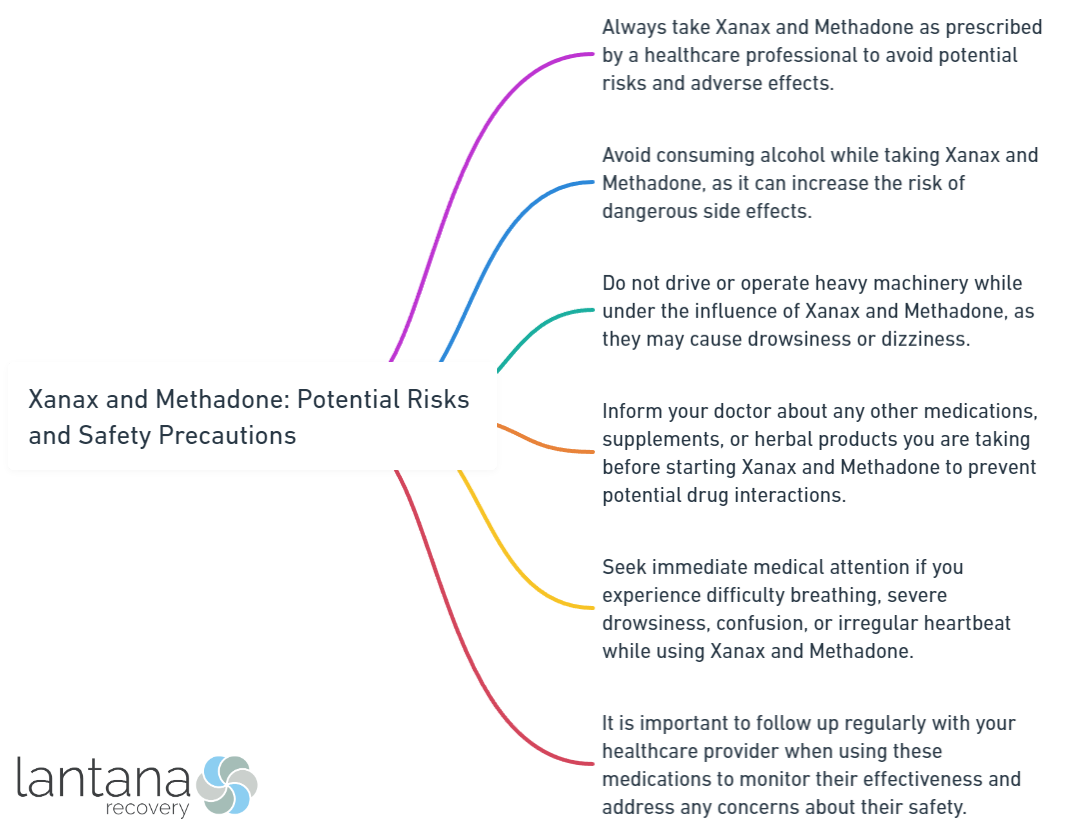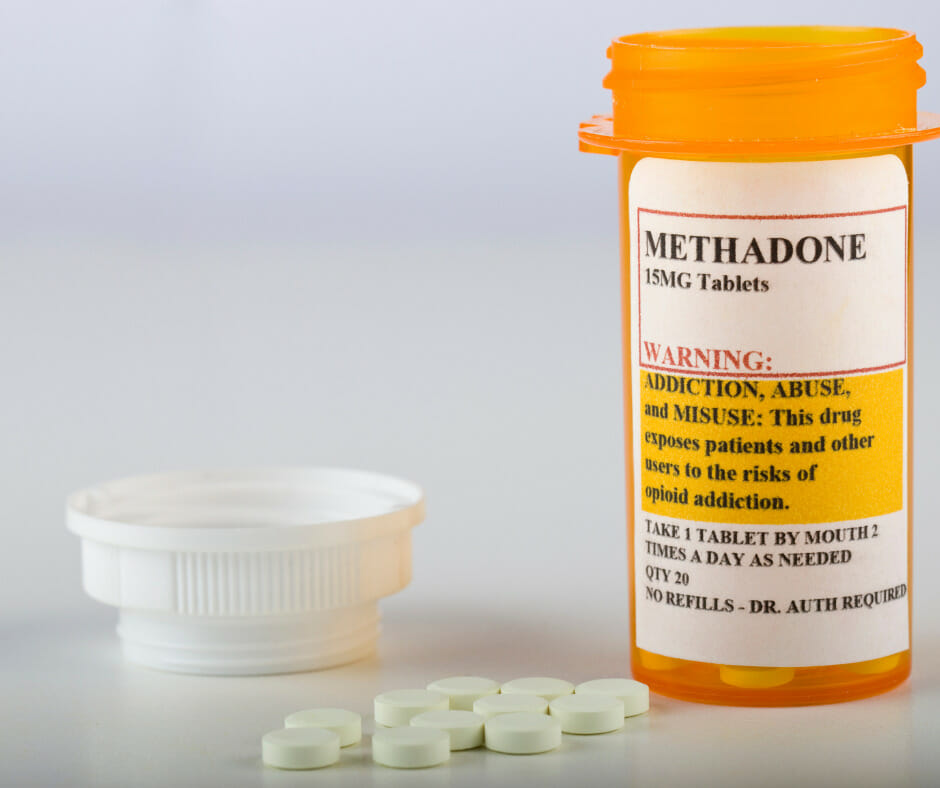Xanax and Methadone are two commonly prescribed medications with distinct uses and effects. It is essential to understand the potential risks and safety precautions associated with their combined use.
Xanax, also known by its generic name Alprazolam, is a prescription medication primarily used to treat anxiety disorders and panic attacks. It belongs to a class of drugs called benzodiazepines that work by enhancing the effects of a neurotransmitter called gamma-aminobutyric acid (GABA). This results in a calming effect on the central nervous system, helping to alleviate anxiety symptoms.
Xanax is prescribed to manage a range of anxiety disorders, including generalized anxiety disorder (GAD), social anxiety disorder (SAD), and panic disorder. It is also used for short-term relief from anxiety symptoms and acute anxiety episodes.
Methadone is a synthetic opioid medication primarily used for the treatment of opioid dependence and chronic pain management. It acts on the opioid receptors in the brain, producing analgesic effects and alleviating withdrawal symptoms in individuals recovering from opioid addiction.
Methadone is commonly used in opioid substitution therapy programs to help individuals reduce or eliminate their dependence on heroin or other opioids. It can also be prescribed for chronic pain management in cases where other pain medications have been ineffective.
The combination of Xanax and Methadone can have potentially dangerous interactions. Both medications depress the central nervous system, leading to sedation and respiratory depression. When taken together, these effects can be intensified, significantly increasing the risk of overdose and other adverse reactions.
Combining Xanax and Methadone can result in excessive sedation, respiratory depression, confusion, dizziness, and impaired cognitive function. The risk of overdose, coma, and even death is significantly increased when these drugs are used together without proper medical supervision.
In most cases, it is not recommended to take Xanax and Methadone together due to the potential risks involved. However, there may be certain circumstances where the benefits of combining these medications may outweigh the risks. It is crucial to consult with a healthcare professional who can assess your specific situation and provide appropriate guidance.
If Xanax and Methadone must be used concurrently, certain safety precautions should be followed. Close monitoring by a healthcare professional is essential to assess the patient’s response to the medications and adjust the dosage if necessary. It is crucial to avoid self-medicating or altering the prescribed doses without medical guidance.
It is important to communicate openly with your healthcare provider about all medications you are taking, including Xanax and Methadone. Adhering to the prescribed doses, avoiding alcohol and other sedatives, and attending regular check-ups and counseling sessions are crucial for ensuring safety while using these medications together.
For individuals who may be concerned about the potential risks associated with the combined use of Xanax and Methadone, there may be alternative treatment options available. It is recommended to discuss alternative therapies and medications with a healthcare professional at institutions like Lantana Recovery to explore safer alternatives that meet the individual’s specific needs.
By understanding the potential risks and adhering to necessary safety precautions and guidelines, individuals can make informed decisions about the combined use of Xanax and Methadone, prioritizing their own well-being and minimizing potential harm.

What is Xanax?
Xanax, also known as Alprazolam, is a prescription medication in the benzodiazepine class. It treats anxiety disorders, panic disorders, and anxiety caused by depression. Xanax enhances the effects of GABA, a neurotransmitter, in the brain. This reduces anxiety and promotes relaxation.
Xanax comes in tablet form and is taken orally. The dosage of Xanax varies based on the individual’s symptoms and response. It is important to follow the prescribed dosage and avoid exceeding it. Misuse of Xanax can lead to dependence, addiction, and other serious health risks.
Xanax is a controlled substance due to its potential for abuse and addiction. It is classified as a Schedule IV drug by the DEA. Use Xanax only under the guidance of a healthcare professional. Common side effects of Xanax include drowsiness, dizziness, blurred vision, and difficulty concentrating. Avoid alcohol and sedatives while taking Xanax to prevent increased side effects.
What are the Uses and Benefits of Xanax?
Xanax is prescribed for anxiety and panic disorders. It alleviates symptoms and helps individuals regain calm. It acts quickly, providing relief and reducing excessive worrying and tension. Xanax can also assist in managing insomnia. It should only be used under the guidance of a healthcare professional to avoid risks such as dependence and addiction. It is essential to follow the prescribed dosage and consult a healthcare professional for any concerns or questions.

What is Methadone?
Methadone is a synthetic opioid medication that is commonly used to treat opioid addiction and chronic pain. It functions by binding to opioid receptors in the brain, which helps in reducing cravings and withdrawal symptoms. Unlike natural opioids, methadone is chemically manufactured.
It’s important to note that methadone can only be obtained with a valid prescription from a healthcare provider. This is because it is a highly potent drug that has the potential for misuse. Therefore, it should only be taken under the supervision of a medical professional.
The dosage of methadone is tailored to meet the specific needs of each individual. Typically, it is taken once a day and is available in different forms such as tablets, liquid, or dissolvable wafers. The specific dosage may vary depending on the severity of the addiction or the level of pain being experienced.
To ensure safety and effectiveness, it is crucial to strictly follow the dosage and frequency instructions provided by your healthcare provider. Taking more or less than prescribed can be extremely dangerous and may lead to overdose or complications.
It’s also important to be aware of the potential side effects of methadone, which can vary from person to person. Some common side effects include constipation, drowsiness, and dry mouth. If you experience any of these side effects, it is essential to consult with your healthcare provider to determine the best course of action.
What are the Uses and Benefits of Methadone?
Methadone is a medication that has multiple uses and benefits. It is commonly prescribed for individuals with opioid addiction or chronic pain. The way methadone works is by attaching to the same receptors in the brain as opioids such as heroin or prescription painkillers. By doing so, it helps to reduce cravings and withdrawal symptoms, facilitating a safe withdrawal from drugs. This medication has been proven to not only decrease drug use but also enhance the overall quality of life for those struggling with addiction.
One notable advantage of methadone is its long-acting properties. Unlike other medications, it only needs to be taken once per day, eliminating the need for frequent dosing and contributing to treatment stability. Moreover, methadone possesses a slower onset and longer duration compared to other opioids, making it particularly effective for managing chronic pain.
In addition to these benefits, methadone can serve as an alternative treatment option for individuals who are unable to tolerate other opioids or have not experienced relief from other pain management strategies. It offers pain relief without the associated risk of respiratory depression.
However, it is crucial to responsibly use methadone under the guidance of a healthcare professional and as part of a comprehensive treatment program to prevent the risk of overdose. When considering its potential benefits and risks, it is important to carefully evaluate individual needs and circumstances.

How Xanax and Methadone Interact
Understanding how Xanax and Methadone interact is crucial for individuals who take or are considering taking both medications. Xanax and Methadone both belong to the group of central nervous system depressants and when used together, they can enhance their sedative effects. This amplification can result in extreme drowsiness, dizziness, and impaired coordination. It is important to note that combining Xanax and Methadone may lead to respiratory depression, which poses a significant danger, particularly for those with respiratory conditions or those who have consumed alcohol.
To ensure safety, patients must inform their healthcare provider about all substances they are using, including prescription drugs, over-the-counter medications, and supplements. This will enable the monitoring of potential drug interactions. Regular monitoring is particularly necessary for patients concurrently using Xanax and Methadone to allow for dosage adjustments and close observation of the respiratory and central nervous systems. It is crucial for patients to always adhere to the prescribed dosage and avoid combining Xanax and Methadone without medical supervision. Increasing the doses or frequency without medical guidance can greatly increase the risks associated with these medications.
If individuals experience adverse effects or overdose symptoms, such as extreme drowsiness, difficulty breathing, or loss of consciousness, they should seek immediate medical attention. Understanding the risks and interactions between Xanax and Methadone is paramount for the safe and effective use of these medications. Therefore, it is essential to consult medical professionals before considering their combined use to prevent potential harm to the body.
What are the Potential Risks of Combining Xanax and Methadone?
Combining Xanax and Methadone can pose potential risks. It is important to understand the dangers associated with this combination:
- Increased sedation is a possible effect of combining Xanax and Methadone, which can lead to drowsiness and impair cognitive function and motor skills. This can make it unsafe to drive or operate machinery.
- Respiratory depression is another risk when using both Xanax and Methadone together. Both medications can depress the respiratory system, and when combined, the risk of difficulty breathing and respiratory failure increases.
- Combining these medications can also intensify the depressant effect on the central nervous system. This may result in confusion, dizziness, and even loss of consciousness.
- Taking Xanax and Methadone together significantly raises the risk of overdose. It is crucial to recognize the signs of overdose, such as slowed breathing, extreme drowsiness, and loss of consciousness. If an overdose is suspected, immediate medical help should be sought.
- Both Xanax and Methadone are addictive, and combining them increases the risk of addiction and dependence. This can lead to withdrawal symptoms when discontinuing their use.
Before combining Xanax and Methadone, or making any changes to medication regimens, it is crucial to consult with a healthcare professional at a reputable institution like Lantana Recovery in Greenville. They can provide personalized advice and guidance to ensure the safest and most effective treatment plan.
Can Xanax and Methadone Be Taken Together Safely?
When considering the use of Xanax and Methadone together, it is crucial to consult with a healthcare professional for guidance on potential risks and interactions.
Xanax, a medication utilized in the treatment of anxiety disorders, functions by enhancing the impacts of the neurotransmitter GABA. Methadone, on the other hand, is employed to address opioid addiction and chronic pain by binding to identical receptors in the brain.
Caution must be exercised when combining Xanax and Methadone due to the possibility of respiratory depression, sedation, and an elevated risk of overdose. Consequently, it is generally advisable to refrain from taking these medications concurrently. However, in certain circumstances where the benefits outweigh the risks, a healthcare professional may closely monitor an individual.
It is important to adhere to safety precautions and guidelines provided by healthcare professionals at institutions like Lantana, which may include commencing with low doses, monitoring for potential side effects, and avoiding substances that depress the central nervous system. To obtain personalized advice and guidance, it is essential to consult with your healthcare provider.

Safety Precautions and Guidelines
When using Xanax and Methadone, it is crucial to prioritize safety precautions and guidelines to ensure the well-being and health of individuals.
- Incorporate safety precautions: It is important to have a valid prescription from a healthcare professional before taking Xanax or Methadone. Self-medication, like using methamphetamine for weight loss, can be harmful.
- Follow dosage instructions: Adhere strictly to the prescribed dosage and frequency of medication. Consult a healthcare provider before making any changes.
- Avoid alcohol and other substances: Combining Xanax or Methadone with alcohol or drugs can cause dangerous interactions, such as increased sedation and respiratory depression. It is advisable to avoid using such substances.
- Inform your healthcare provider: To prevent potential drug interactions, it is necessary to inform your healthcare provider about all medications, including over-the-counter drugs and supplements.
- Regular check-ups: Visiting your healthcare provider regularly for monitoring and evaluation allows for necessary adjustments to dosage and treatment plans.
- Safe storage: To prevent misuse or accidental ingestion, it is important to keep Xanax and Methadone in a secure location, away from children and individuals without a prescription.
Prioritizing safety and well-being is vital when using Xanax and Methadone. By following these safety precautions and guidelines, it is possible to mitigate potential risks and ensure responsible use of these medications.
What are the Safety Measures to be Taken While Using Xanax and Methadone?
When using Xanax and Methadone, it is crucial to follow safety measures in order to ensure your well-being and minimize any associated risks. Here are some important safety measures to consider:
1. Consult with a healthcare professional: Before initiating the use of Xanax or Methadone, it is essential to consult a healthcare professional who can assess your medical history and provide proper guidance regarding their usage.
2. Adhere to the prescribed dosage: It is imperative to take Xanax and Methadone exactly as prescribed by your doctor. Avoid surpassing the recommended dosage or taking them more frequently than instructed.
3. Steer clear of alcohol and other substances: To prevent any negative interactions, it is important to avoid consuming alcohol and other substances that may have adverse effects when combined with Xanax or Methadone. The combination of these substances can increase the risk of side effects and potentially lead to overdose.
4. Refrain from driving or operating heavy machinery: Both Xanax and Methadone have the potential to cause drowsiness and impair cognitive functions. It is crucial to avoid activities such as driving or operating heavy machinery until you are aware of how these medications affect you.
5. Monitor for potential side effects: It is vital to remain vigilant for any potential side effects such as dizziness, confusion, slowed breathing, or excessive sedation. If you experience any of these symptoms, it is important to immediately contact your healthcare professional.
6. Ensure the security of your medications: To prevent misuse, it is important to store Xanax and Methadone in a secure place that is inaccessible to children and individuals who may misuse them. Additionally, make sure to properly dispose of any unused medication.
7. Regularly review your treatment plan: Staying in close contact with your healthcare professional is important in order to discuss the effectiveness of your treatment and assess any potential risks. Regular monitoring will ensure a safe and effective treatment.
Remember, it is crucial to adhere to these safety measures in order to protect your health while using Xanax and Methadone. “Recommendations have been formulated to guide methadone providers in avoiding or minimizing risks associated with induction, including careful dosing, gradual escalation, and awareness of potential drug interactions” (Safe Methadone Induction and Stabilization: Report of an Expert Panel, Baxter et al., 2013.) For personalized guidance and advice, it is highly recommended to consult a healthcare professional. Additionally, prioritize open communication with your healthcare professional and diligently follow their instructions for the best possible outcome.
Alternative Treatments and Options
Are there any Safer Alternatives to Xanax and Methadone?
There are safer alternatives to Xanax and Methadone. It’s important to consider consulting with a healthcare professional at an expert institution like Lantana for personalized advice. Here are some potential alternatives to consider:
-
Cognitive Behavioral Therapy (CBT): CBT is a form of talk therapy that can help individuals identify and change negative thought patterns and behaviors. It has been found to be effective in managing anxiety and reducing the need for medications like Xanax.
-
Natural supplements: Some individuals find relief from anxiety symptoms by incorporating natural supplements such as Valerian root, chamomile, or passionflower. These supplements promote relaxation and calmness, potentially offering an alternative to Xanax and Methadone.
-
Mindfulness and meditation: Utilizing mindfulness and meditation techniques can play a significant role in managing stress and anxiety. By focusing on the present moment, these practices can provide a sense of calm and clarity, acting as an alternative to Xanax and Methadone.
-
Exercise: Regular physical activity, whether it’s walking, swimming, or engaging in yoga, can greatly reduce anxiety symptoms. Exercise releases endorphins, which can improve mood and overall well-being. This can be an effective alternative to Xanax and Methadone.
-
Support groups: Becoming a part of therapy or support groups can create a sense of community and connection. Sharing experiences with others who face similar challenges can be beneficial in managing anxiety and can provide an alternative to Xanax and Methadone.
It is important to note that these alternatives may not be suitable for everyone and should be discussed with a healthcare professional. Individual needs and circumstances vary, and consulting with a healthcare professional can help determine the most appropriate course of action.
Frequently Asked Questions
What are Xanax and methadone?
Xanax is a benzodiazepine used to treat anxiety and panic disorders, while methadone is a synthetic analgesic opioid used for moderate to severe pain and opioid use disorder.
What are the potential risks of taking Xanax and methadone together?
Taking Xanax and methadone together can intensify their effects and lead to health issues and overdose. Both drugs are central nervous system depressants, and combining them can suppress the respiratory system and cause breathing difficulties, potentially resulting in fatal outcomes.
Can methadone and Xanax cause addiction and withdrawal symptoms?
Yes, both methadone and Xanax have the potential for addiction and physical dependence. Abruptly stopping these medications can lead to withdrawal symptoms such as anxiety, restlessness, insomnia, muscle aches, and tremors. It is important to follow a doctor’s guidance when discontinuing these drugs.
What are the possible side effects of Xanax and methadone?
Common side effects of Xanax include drowsiness, confusion, memory problems, stomach pains, muscle weakness, fatigue, headaches, and constipation. Methadone can cause side effects such as constipation, drowsiness, difficulty breathing, mood swings, blurred vision, excessive sweating, and nausea. However, both drugs can also have more serious side effects such as respiratory problems and low blood pressure.
Is it safe to mix Xanax and methadone with other substances?
No, it is not safe to mix Xanax and methadone with other substances without the advice and prescription of a doctor. Combining these medications with other substances, including alcohol or other drugs, can increase the risks of adverse side effects, overdose, and addiction.
What should I do if I am struggling with Xanax and methadone abuse?
If you or a loved one is struggling with Xanax and methadone abuse, professional treatment and rehabilitation may be necessary. Contact a drug and alcohol treatment center like Lantana Recovery in Greenville for more information about their resources and services to help achieve long-term sobriety and address addiction cravings.









